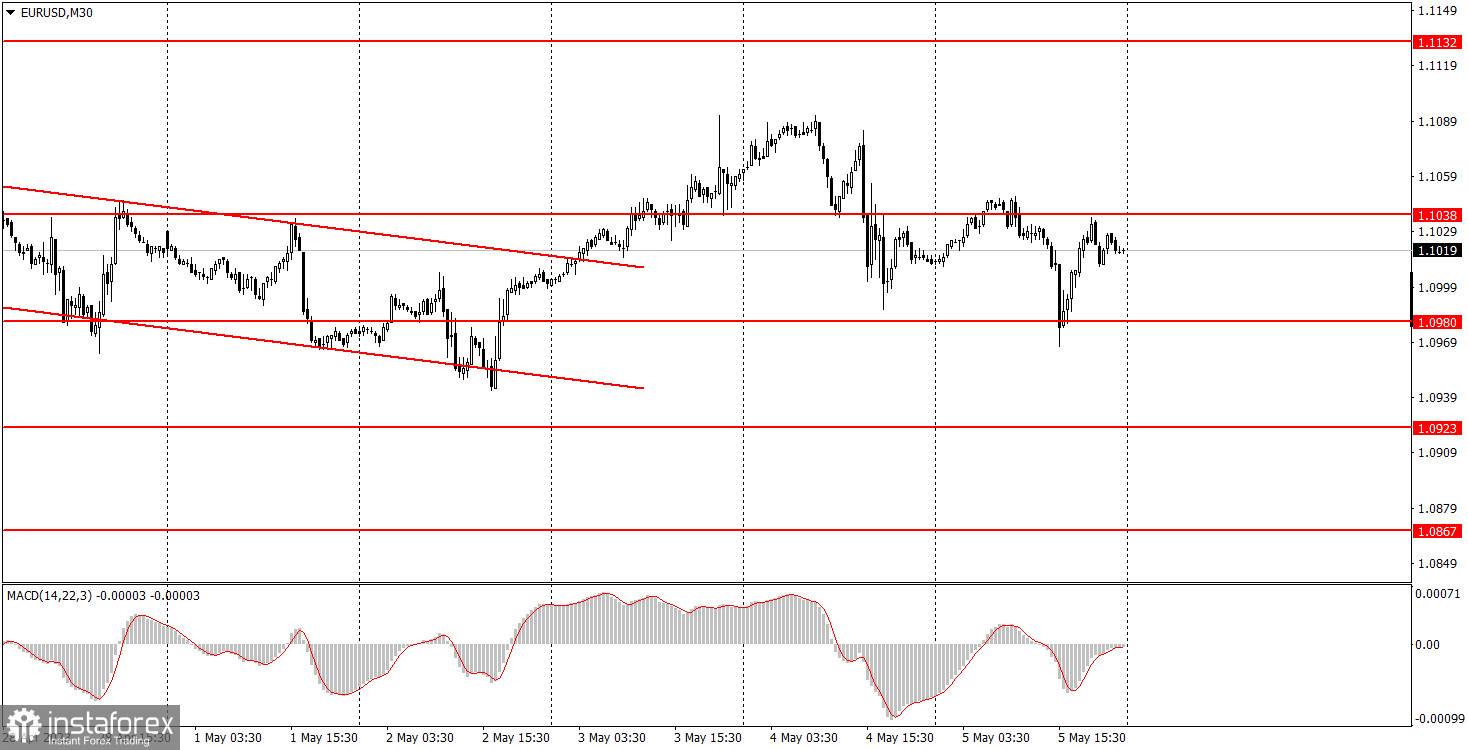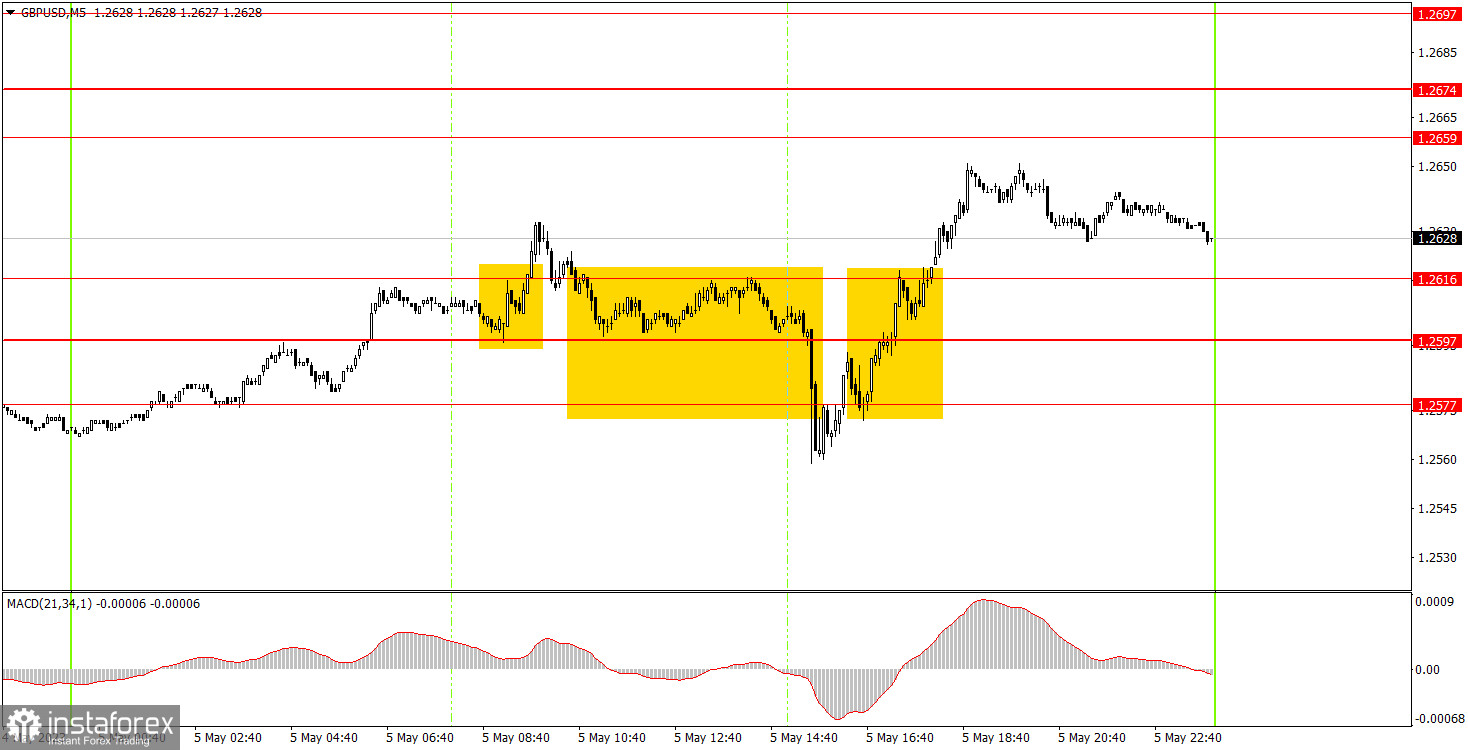Analyzing Friday's trades:
EUR/USD on 30M chart

On Friday, the EUR/USD pair showed volatility equal to 80 points. This is quite a modest value for a day when important data on the US labor market and unemployment were to be published. It is not even worth mentioning what the market's reaction was to the reports. The number of Nonfarm Payrolls in April exceeded forecasts by 60,000, the unemployment rate dropped to a record low of 3.4%, and the dollar appreciated by 50 points and lost all its slight advantage by the end of the day. Therefore, formally, the market should have worked on buying the dollar based on strong US data, but in fact, we saw the same thing as before: the absence of growth in the dollar even when there are reasons for it. Someone might say that the March value of NonFarm Payrolls was revised downward, so the dollar could not show significant growth. We believe that this is not the reason, as even in this case, the labor market remains very strong, as does the economy. Unlike the European Union economy. But the market does not want to sell the pair, so the dollar does not grow in any macroeconomic context.
EUR/USD on 5M chart

On the 5-minute chart, the pair moved quite well on Friday. First, we saw a downturn, then an upturn, without frequent reversals and pullbacks. Therefore, the trading signals were good. First, the pair rebounded not very accurately from the 1.1038 level, which had to be worked out with a short position. A few hours later, the quotes reached the area of 1.0980-1.0965, from which there was also a rebound. You could keep short positions even during the release of the US data, as by that time, the pair had passed 15 points downwards, and novice traders could set a Stop Loss for the transaction at breakeven. The profit on the transaction was about 35 points. The buy signal could also be worked out, and you could earn another 30 points, as the price managed to return to 1.1038 by the evening. As a result, it was a decent trading day, and a decent profit was made.
Trading tips on Monday:
On the 30-minute chart, the EUR/USD pair started a new downward movement within the general flat. The "swings" continue, and the fundamental and macroeconomic backgrounds do not lead to a logical reaction. The euro remains at high, unjustified values and is still overbought. On the 5-minute chart, it is recommended to trade at the levels 1.0792, 1.0857-1.0867, 1.0920-1.0933, 1.0965-1.0980, 1.1038, 1.1070, 1.1132, 1.1184, 1.1228. As soon as the price passes 20 pips in the right direction, you should set a Stop Loss to breakeven. On Monday, no important events or reports are planned in either the European Union or the US. Most likely, there will be a flat.
Basic rules of the trading system:
1) The strength of the signal is determined by the time it took the signal to form (a rebound or a breakout of the level). The quicker it is formed, the stronger the signal is.
2) If two or more positions were opened near a certain level based on a false signal (which did not trigger a Take Profit or test the nearest target level), then all subsequent signals at this level should be ignored.
3) When trading flat, a pair can form multiple false signals or not form them at all. In any case, it is better to stop trading at the first sign of a flat movement.
4) Trades should be opened in the period between the start of the European session and the middle of the US trading hours when all positions must be closed manually.
5) You can trade using signals from the MACD indicator on the 30-minute time frame only amid strong volatility and a clear trend that should be confirmed by a trendline or a trend channel.
6) If two levels are located too close to each other (from 5 to 15 pips), they should be considered support and resistance levels.
On the chart:
Support and Resistance levels are the levels that serve as targets when buying or selling the pair. You can place Take Profit near these levels.
Red lines are channels or trend lines that display the current trend and show in which direction it is better to trade now.
The MACD indicator (14, 22, and 3) consists of a histogram and a signal line. When they cross, this is a signal to enter the market. It is recommended to use this indicator in combination with trend patterns (channels and trendlines).
Important announcements and economic reports that can be found on the economic calendar can seriously influence the trajectory of a currency pair. Therefore, at the time of their release, we recommend trading as carefully as possible or exiting the market in order to avoid sharp price fluctuations.
Beginners on Forex should remember that not every single trade has to be profitable. The development of a clear strategy and money management is the key to success in trading over a long period of time.





















